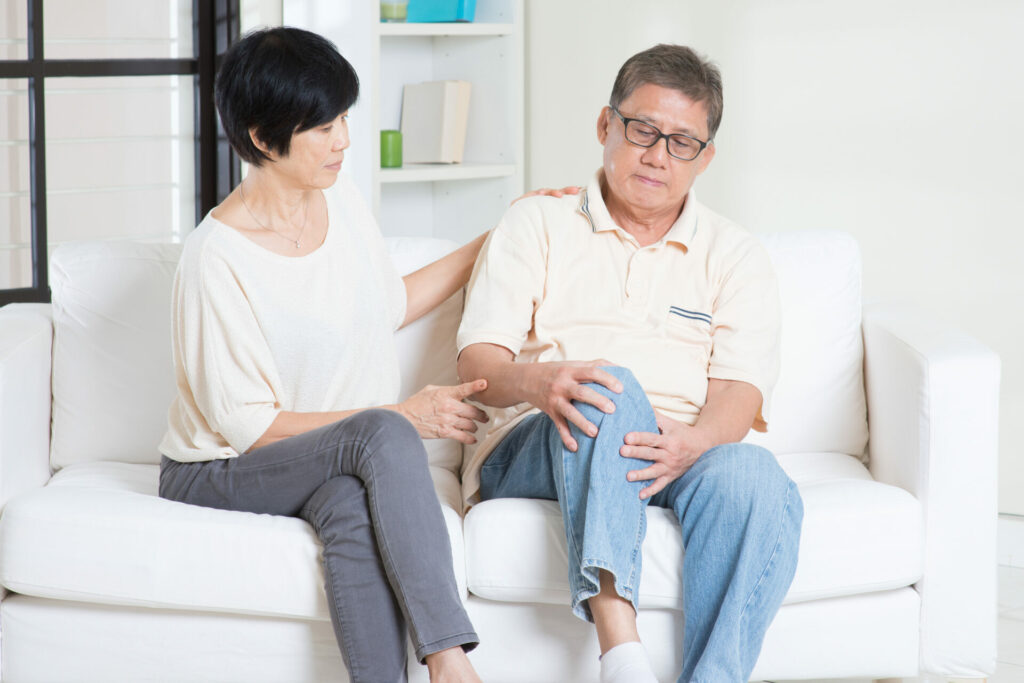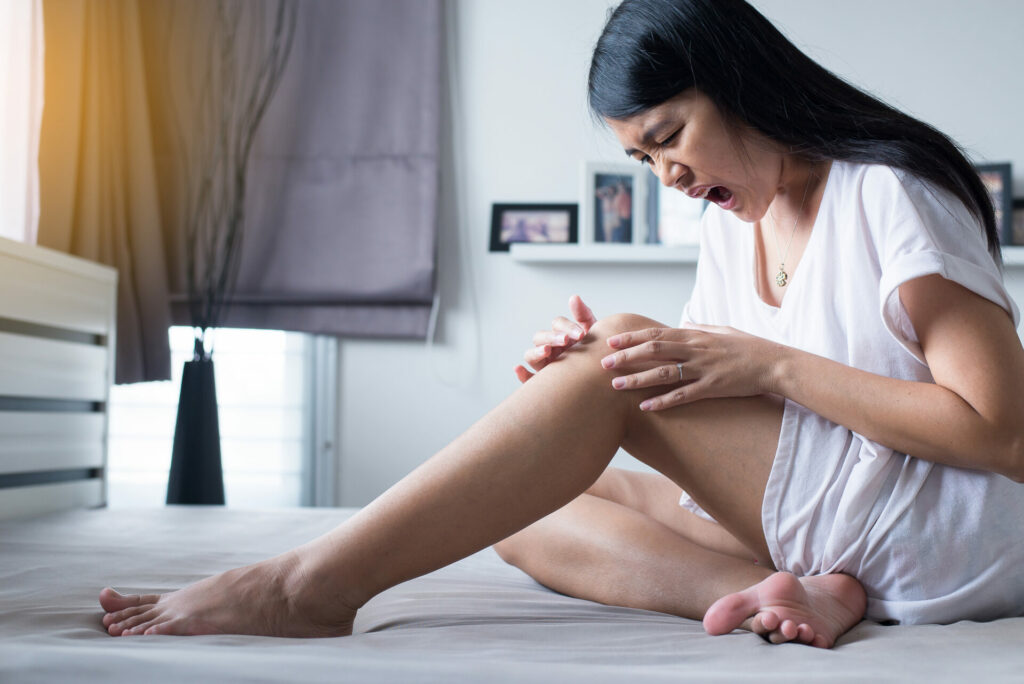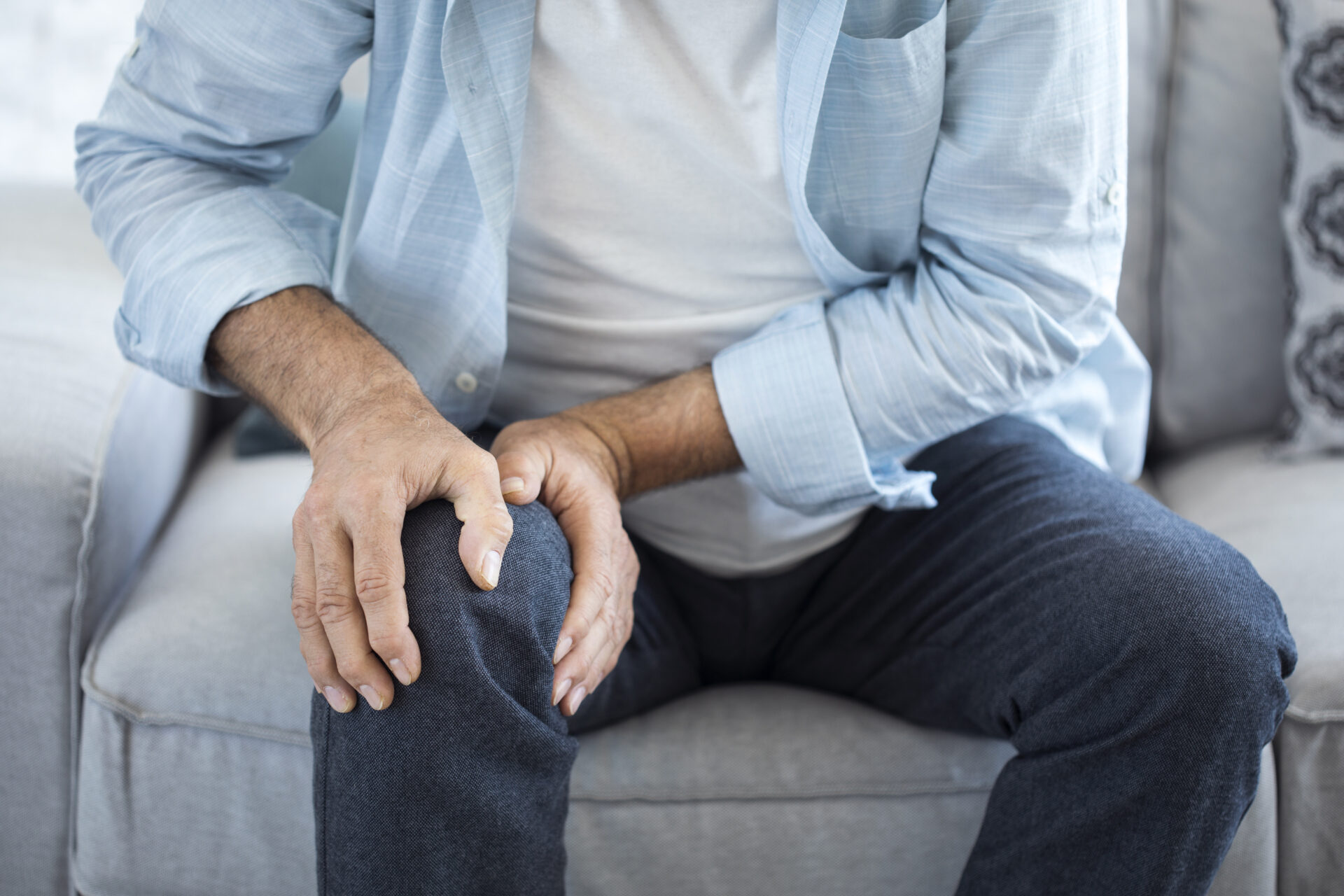If you’ve suddenly developed a painful knee, you may wonder how you injured it. It’s common to over-analyse your every movement over the past few days, trying to work out how you hurt your knee.
But sometimes, knee pain has nothing to do with the knee joint at all. Knee pain from sciatica is a potential cause for your mystery knee pain. In this article, we’ll explore how sciatica can cause knee pain, what else could be causing your knee pain, and what you can do to relieve your symptoms.
Table of Contents
- What does sciatic pain in the knee feel like?
- What is sciatica?
- How can sciatica cause knee pain?
- What else could be causing my knee pain?
- How do I know if sciatica is causing my knee pain?
- Tips for relieving sciatica that affects the knee
- What treatments are there for sciatica that affects the knee?
- When should I get medical advice?
- Is it better to rest or exercise with knee pain from sciatica?
- What position should I sleep in with knee pain from sciatica?
- Harley Street Specialist Hospital can help
What does sciatic pain in the knee feel like?
If your knee pain is caused by sciatica, you may have a dull ache, sharp pain or altered sensation at the front, back or side of your knee. You may have weakness in your knee and struggle to take your weight on it, or it may give way.
Pain elsewhere could be a sign that sciatica is causing your knee pain. If you also have pain in your lower back, buttock, thigh, foot or calf, sciatica could be the cause of your knee pain. Also, less commonly, sciatica can cause groin pain.
What is sciatica?
Symptoms of sciatica include weakness, tingling or numbness, and shooting pain in your legs, lower back or buttocks [1]. Sciatica in both legs is less common and is called bilateral sciatica.
Sciatica occurs when the sciatic nerve is inflamed and compressed [2]. This has many potential causes, including a herniated disc, osteoarthritis, injuries or spinal stenosis. You can also get sciatica in pregnancy because of the increased pressure on your spine.
An accurate diagnosis is essential to choose the best sciatica treatment option. Harley Street Specialist Hospital has a team of specialists who can diagnose the cause of your sciatica and help you decide which treatment is right for you.
How can sciatica cause knee pain?
Sciatica is usually caused by a problem in your lower back that puts pressure on your sciatic nerve. These symptoms can travel into your legs and cause knee pain, even though the root cause has nothing to do with your knee.
Lumbar radiculopathy
Lumbar means lower back, and radiculopathy means damage to the nerve roots where they leave the spine. This can be due to a herniated disc, spinal stenosis, osteoarthritis or several other reasons. You are more likely to develop lumbar radiculopathy as you get older [3].
When your sciatic nerve root gets compressed in your lower back, pain can refer down your leg and into your knee. Sometimes your knee is the only place where you feel pain, which can make it hard to work out the cause of your knee pain.
That’s where specialist assessment can help. Harley Street Specialist Hospital’s team of doctors, physiotherapists and radiographers know how to identify knee pain caused by sciatica and can often offer treatment on the same day.
Tight hamstrings
Your hamstrings are the muscles at the back of your thighs. Tight hamstrings can also cause sciatica with knee pain.
Tight hamstrings put extra pressure on your lower back by changing the curvature of your spine. This can stress your spinal joints and put pressure on your sciatic nerve, leading to sciatica with knee pain [4].

What else could be causing my knee pain?
Although sciatica can cause knee pain, there are several other conditions that could also be causing your knee pain. We’ve listed a few of the most common conditions below.
Knee arthritis
Osteoarthritis usually affects people who are middle-aged and older, and 16% of people worldwide have knee osteoarthritis [5]. Sometimes, younger people can also be affected if their joints are a particular shape.
You are more likely to get knee osteoarthritis if you are overweight, live a sedentary lifestyle, or have a body shape that puts more pressure on your knee joints [6]. Arthritis in the knee feels like a dull ache or sharp pain with knee stiffness. Your knee may even hurt when you bend and straighten it.
Rheumatoid arthritis often affects people from a younger age than osteoarthritis [7]. This type of arthritis can also lead to knee pain by causing inflammation in your knee and damaging the cartilage.
Meniscus tear
The meniscus (cartilage) in your knee acts as cushioning in your knee joint. It helps to absorb impact and protect the bones of your knee joint from damage. Meniscus tears are more common in men than women [8].
Meniscus tears can be caused by a twisting injury (such as landing with your knee twisted when playing football) or through degenerative change over time. Like the bones of your knee joint, your meniscus also suffers from wear and tear. Degenerative meniscus tears are common in older people.
Muscle strain
A muscle strain is a tear in part of your muscle. There are many different muscles that connect to the knee joint, such as your hamstrings, calf muscles and quad muscles. Knee pain is common when any one of these muscle groups becomes strained.
Muscle strains can cause pain at the front, back or side of your knee, depending on which muscle is injured. Muscle strains can have acute or chronic causes. An acute strain is caused by an injury (such as landing in the wrong position after jumping) or lifting something too heavy. A chronic strain is caused by doing the same movement repeatedly until it damages the muscle.
Ligament sprain
A ligament sprain is a tear in one of your ligaments. There are four main ligaments in your knee: the anterior cruciate ligament (ACL), the posterior cruciate ligament (PCL), the medial collateral ligament (MCL), and the lateral collateral ligament (LCL). You can partially tear a ligament or tear it completely (known as a rupture).
Knee ligament injuries are often caused by sports injuries, such as landing from a jump incorrectly. The PCL is the hardest ligament to injure, and most PCL injuries happen with severe knee trauma [9].
Tendonitis
Tendonitis describes inflammation of your tendons. Your hamstring tendons, quadriceps tendons, patella tendon and iliotibial band are all tendons that could cause knee pain if inflamed.
You can get tendonitis from overusing a tendon, for example during activities like running or cycling. Patellar tendonitis is known as jumper’s knee because people often get it from sports that involve jumping like basketball.

How do I know if sciatica is causing my knee pain?
The best way to find out what’s causing your pain is to book an appointment with a specialist. At Harley Street Specialist Hospital, we have a state-of-the-art diagnostic imaging centre and expert consultants to help you understand the cause of your knee pain.
Once you have a diagnosis, you’ll have various treatment options available. Often, treatment can start on the same day you receive a diagnosis.
Tips for relieving sciatica that affects the knee
Here are a few things you can try straight away to see if your knee pain from sciatica improves.
Move regularly
Staying in one position for long stretches of time can make sciatica worse. This is particularly true for sitting, and people who work at a desk often find their sciatica feels much worse when they finally stand up.
Try to take short movement breaks as often as you can, even if it’s just walking across the room to get a glass of water. This position change can sometimes help relieve pressure on your sciatic nerve and improve knee pain.
Gentle exercise
Gentle movement like swimming, stretching or walking is good for sciatica. Choose the movement that feels best for you. If a movement improves your pain, that’s a sign to try that movement more regularly.
Heat, ice and pain relief
Heat, ice or pain medication can help you get better more quickly. We tend to move unnaturally or avoid movement when we’re in pain. By reducing your pain levels and getting immediate relief for sciatica, you move more normally, which can help to speed up the recovery process.

What treatments are there for sciatica that affects the knee?
If your knee pain is caused by sciatica, medical treatment will focus on treating the underlying condition that is causing the sciatica. Harley Street Specialist Hospital can help to diagnose and treat your knee pain from sciatica. Here are a few of the services we offer:
Physiotherapy
Our highly trained physiotherapy team can diagnose and treat knee pain from sciatica. Our specialists are trained in exercise therapy, acupuncture for sciatica, massage for sciatica relief, manual therapy and a range of other treatment modalities.
Our physiotherapists can also diagnose and treat your knee if the pain is caused by something other than sciatica. Physiotherapy can be helpful for knee arthritis, meniscus tears, injuries to muscles and ligaments, and many other knee conditions.
Pain management
Our pain management unit has a team of specialists who can assess and treat you on the same day. We offer a wide range of pain management therapies including steroid injections and other types of injections for back pain that can also help relieve knee pain from sciatica.

Surgery
Harley Street Specialist Hospital works with a team of world-renowned neurosurgeons and spinal surgeons. If you need surgery for your sciatica and knee pain, they can offer the best treatment to cure sciatica permanently and ensure you feel in control and at ease throughout the process.
When should I get medical advice?
If your leg or lower back pain is so severe you can’t move, or there are no signs of the sciatica improving after a week or two of home treatment, seek medical advice. You should speak to your doctor as soon as possible if you experience:
- Weakness in your legs or feet that’s getting worse
- Changes to your bladder or bowel function
- Numbness or altered sensation in your groin area
- Pain and altered sensation in both legs that’s getting worse
Is it better to rest or exercise with knee pain from sciatica?
When sciatica flares up, it may be necessary to have a short initial period of rest and limited movement. You may not physically be able to continue your daily activities – sometimes sciatica can be so bad you can’t walk – and it’s never recommended to force through pain.
But as soon as possible, you should get moving gently again. Long periods of limited movement usually make sciatica and associated knee pain worse.
Staying active works better to relieve sciatica pain than resting in bed [10]. If you’re unsure which movements are best for you, book an appointment with a physiotherapist. Physiotherapists prescribe specific exercises that can improve pain and movement when you have sciatica [11].
What position should I sleep in with knee pain from sciatica?
You should sleep in whichever position is most comfortable for you. Sleep helps speed up healing [12], so getting a good night’s sleep is vital if possible.
If you’re struggling to work out how to sleep with sciatica, try using an extra pillow. Place it under your knees if you sleep on your back, and between your knees if you sleep on your side. This can help to relieve pressure on your lower back and, in turn, improve your knee pain from sciatica.

Harley Street Specialist Hospital can help
If you’re struggling with knee pain from sciatica, our specialist team can help. Whether it’s sciatica causing your knee pain or something else, we can provide an expert assessment and a range of treatment options.
There are no long waiting lists here – we pride ourselves on offering rapid assessment and treatment. Book an appointment today to get started with your journey to recovery.




